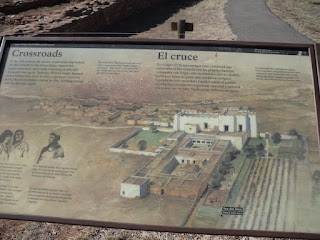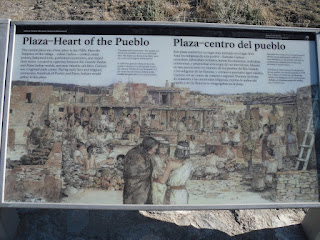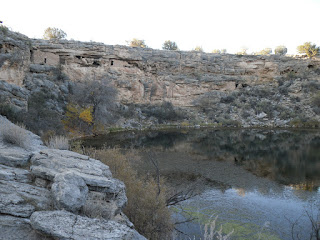November 28th, 2009-- After a day of recuperating from the food induced comma of Thanksgiving it was time stretch out the legs and tackle something big. Dubbed our first annual "man hike", me and a few of the guys headed out into the frozen tundra of late November to conquer Mount Taylor. Reaching the peak of Mount Taylor, a 11,300 foot peak near Grants, New Mexico, involves about a strenuous 7 mile round-trip hike with exceptional views of the valleys below.
With an eminent storm coming (Sunday) with the possibility of snows we knew we had an urgency to tackle Mount Taylor as possibly our last hike before winter is really upon us here in New Mexico. The hike begins in a conifer forest with pine needles cushioning every step. In the shadows there was crusted snow and few footprints.
As the elevation increased we found ourselves out of the forested area and into the grassy clearings and extensive meadows that surround the summit of Mount Taylor. We started our trek with temperatures in the mid 40's but the higher we ascended the lower the temperatures dropped. Finding ourselves less than a mile from the summit the exposed clearings did little to shield us from the chilling winds.
Reaching the summit we noticed the frost on the evergreens which stood as sentinels guarding the peak. After enjoying our lunches and stopping to let the sweat on our backs begin to chill us it was time to retreat the summit.
We made great time and enjoyed the feeling coming back to our frozen hands each step we took in the decent. In actuality the temperature never rose above 45 degrees in the valley but it felt great nevertheless compared to the cold at 11,300 feet.
Mount Taylor was a great hike, and excellent opportunity to feel sense of accomplishment after gluttonus Thanksgiving indulgence!
Saturday, November 28, 2009
Wednesday, November 25, 2009
Salinas Pueblo Missions
November 25th, 2009-- The Salinas Pueblo Missions National Monument consists of three incredible pueblo site complexs spread across the Salinas valley in central New Mexico.
Our first stop was Abo.
Described as a thriving community with the Spaniards first made it to the Salinas Valley in 1582, the people of Abo had a long tradition of trade with those of the Acoma-Zuni region. Soon the Franciscans would seek to convert the indigenous people to Christianity by building a formidable and sophisticated buttressed church in the heart of the pueblo. However, in the 1670's the pueblo and mission lay desolate and abandoned as those who for so long called this place home retreated to the Rio Grande valleys for protection only never to return.
Today, Abo is a simple and quite place off the beaten path where rubble mounds hide the evidence of pueblo daily life and the three story ruins of the church stands picturesque as if clinging to a former glory.
My "travel" buddy simply loved collecting rocks while the empty doorways of buildings still standing seemed to call me in...We spent nearly an hour at this site and then we were off to the largest of the Salinas pueblos- Gran Quivira.
After refueling, stocking up on all the roadtrip food, and taking a picture of the historic Shaffer Hotel in Mountainarre, NM (an ecletic hotel in it's prime, reflecting the spirit of the Anasazi through the iconic decorations which had more pure meaning than those stolen and corrupted by Nazi Germany) we were off headed down the lonely state highway 25 to Gran Quivira (also known as "Las Humanas").
Gran Quivira has a small visitors center with some impressive exhibits on the pottery of the pueblo. Once an important and lively community now the pueblo and remains of two churches lay in ruin atop a the hills overlooking vast area. Strikingly different about the site is the absence of red clay and mortar, instead the pueblo and churches are built in a beautiful white limestone that is reminiscent of a scene in the Yucatan or Caribbean.
For years this was the site of cultures clashing and mixing. Native traditions blended with Spanish rule under the guise of Christianity. At times such merging of culture came peacefully, at times through force. Obvious are the kivas within steps of the churches, and then there is also evidence of underground hidden kivas.
Getting late in the afternoon and with one more of the Salinas Mission Pueblos to see before dusk we left Gran Quivira and headed to Quarai.
Quarai, sits outside of the small soon to be extinct town of Punta de Agua. With old cars and whethered buildings the town looks as if progress has forgotten this small little community.
West of the town the National Park Service protects Quarai. Like Ago and Gran Quivira, Quarai was "a thriving pueblo when Onate first apprached it in 1598 to accept its oath of allegiance to Spain" (NPS brochure).
Today the site is home to the best preserved churches of the Salinas Mission Pueblos.
Reaching the site before dusk the windows framed the moon and golden light gave an illuminating glow to the red-walled fortress.
Our adventure to the Salinas Mission Pueblos took the better part of the day but images of civilization long vanished will continue to feed the imagination.
For more information on the Salinas Mission Pueblo National Monument visit the National Park Service site here.
Our first stop was Abo.
Described as a thriving community with the Spaniards first made it to the Salinas Valley in 1582, the people of Abo had a long tradition of trade with those of the Acoma-Zuni region. Soon the Franciscans would seek to convert the indigenous people to Christianity by building a formidable and sophisticated buttressed church in the heart of the pueblo. However, in the 1670's the pueblo and mission lay desolate and abandoned as those who for so long called this place home retreated to the Rio Grande valleys for protection only never to return.
Today, Abo is a simple and quite place off the beaten path where rubble mounds hide the evidence of pueblo daily life and the three story ruins of the church stands picturesque as if clinging to a former glory.
My "travel" buddy simply loved collecting rocks while the empty doorways of buildings still standing seemed to call me in...We spent nearly an hour at this site and then we were off to the largest of the Salinas pueblos- Gran Quivira.
After refueling, stocking up on all the roadtrip food, and taking a picture of the historic Shaffer Hotel in Mountainarre, NM (an ecletic hotel in it's prime, reflecting the spirit of the Anasazi through the iconic decorations which had more pure meaning than those stolen and corrupted by Nazi Germany) we were off headed down the lonely state highway 25 to Gran Quivira (also known as "Las Humanas").
Gran Quivira has a small visitors center with some impressive exhibits on the pottery of the pueblo. Once an important and lively community now the pueblo and remains of two churches lay in ruin atop a the hills overlooking vast area. Strikingly different about the site is the absence of red clay and mortar, instead the pueblo and churches are built in a beautiful white limestone that is reminiscent of a scene in the Yucatan or Caribbean.
For years this was the site of cultures clashing and mixing. Native traditions blended with Spanish rule under the guise of Christianity. At times such merging of culture came peacefully, at times through force. Obvious are the kivas within steps of the churches, and then there is also evidence of underground hidden kivas.
Getting late in the afternoon and with one more of the Salinas Mission Pueblos to see before dusk we left Gran Quivira and headed to Quarai.
Quarai, sits outside of the small soon to be extinct town of Punta de Agua. With old cars and whethered buildings the town looks as if progress has forgotten this small little community.
West of the town the National Park Service protects Quarai. Like Ago and Gran Quivira, Quarai was "a thriving pueblo when Onate first apprached it in 1598 to accept its oath of allegiance to Spain" (NPS brochure).
Today the site is home to the best preserved churches of the Salinas Mission Pueblos.
Reaching the site before dusk the windows framed the moon and golden light gave an illuminating glow to the red-walled fortress.
Our adventure to the Salinas Mission Pueblos took the better part of the day but images of civilization long vanished will continue to feed the imagination.
For more information on the Salinas Mission Pueblo National Monument visit the National Park Service site here.
Little Black Mountain
November 26, 2008-- Okay so the "datestamp" might be a be a bit suspicious if you notice "2008" but I've wanted to post some pictures of a great adventure we had last year during Thanksgiving. After all the traditions of turkey and indulgence, we headed out on the four-wheelers for Little Black Mountain, Arizona just south of St. George, Utah.
The site has some phenomenal petroglyphs at the base of a 500 ft. Mesa. I just had to share these photos because it was another trip I am thankful for this time of year...
The site has some phenomenal petroglyphs at the base of a 500 ft. Mesa. I just had to share these photos because it was another trip I am thankful for this time of year...
Happy Thanksgiving!
Tuesday, November 24, 2009
Los Lunas Decalogue
November 24, 2009-- Almost 17 miles from my home in Los Lunas sits an oddity which has captivated my curiosity since first moving to New Mexico… the Los Lunas Decalogue; an-enigma-wrapped-in-mystery-experienced-with-both-a-skepticism-and-profound-sense-of-wonder.
The first recorded mention of the Los Lunas “Commandment Rock” was supposedly in 1933 when a professor from the University of New Mexico
It took me almost two months to secure a permit from Sante Fe after paying a $25 “recreational access permit” from the State Land Office, a fee normally a bit too steep but my interest in exploring such an oddity outweighed financial prudence.
After finding directions to either Hidden Mountain Mystery Mountain
The morning was cold but clear and there is a serenity being in the middle of nowhere. Human tracks are everywhere on the mountain, hence the beer bottles, bullets, junk and vandalism; however, evidence of earlier occupation is also found. I saw a number of petroglyphs, rock shelters, etc.
The inscription itself is perplexing. Vandals scratched out the first line in 2006, but evidence of letters spelling “YHWH” are clearly visible (means Yahweh). I don’t know what to think of the stone; the only conclusion I felt I can offer after experiencing the stone for myself, is that certainly someone had to go out of their way to inscribe what has been so sacred to so many on an obscure boulder in the middle of nowhere. The why’s, how’s, and motives will have to be left to others to resolve.
For the wikipedia entry on the Los Lunas Decalogue visit here, or for a very interesting description visit http://econ.ohio-state.edu/jhm/arch/loslunas.html.
Monday, November 23, 2009
Montezuma's Castle and Montezuma Well
November 23, 2009--- 50 miles south of Flagstaff, Arizona just off I-17 remains evidence of an imposing castle like cliff dwelling perched nearly 100 ft off the valley floor. Today Montezuma Castle National Monument is home to interpretive trails, a small visitor center and gawking tourists but anciently Southern Sinagua famrers began building a five-story, 20-room dwelling as early as the 1100's.
I reached the park an hour before sunset and because of it's easy access and well groomed interpretive trail I made great time exploring Montezuma Castle. Visitors can no longer climb and access the actual dwelling, however, the monument has undergone extensive restoration to remain picturesque.
As impressive as the castle is, my true ambition on this trip was to see Montezuma Well. Nearly five miles up the canyon from Montezuma's Castle a limestone sink formed by the collapse of an immense underground cavern. With a spring flowing into the sink Southern Sinagua farmers irrigated and harnessed the water.
Overlooking the well various dwellings stand watch over the beautiful waters.
Montezuma Well is a lush oasis which provides a stark contrast to the arid desert surrounding the area. It is of little wonder why the ancients would find such a place home.
For more information on Montezuma's Castle and Montezuma Well visit the National Parks site.
I reached the park an hour before sunset and because of it's easy access and well groomed interpretive trail I made great time exploring Montezuma Castle. Visitors can no longer climb and access the actual dwelling, however, the monument has undergone extensive restoration to remain picturesque.
As impressive as the castle is, my true ambition on this trip was to see Montezuma Well. Nearly five miles up the canyon from Montezuma's Castle a limestone sink formed by the collapse of an immense underground cavern. With a spring flowing into the sink Southern Sinagua farmers irrigated and harnessed the water.
Overlooking the well various dwellings stand watch over the beautiful waters.
Montezuma Well is a lush oasis which provides a stark contrast to the arid desert surrounding the area. It is of little wonder why the ancients would find such a place home.
For more information on Montezuma's Castle and Montezuma Well visit the National Parks site.
Subscribe to:
Posts (Atom)






















































